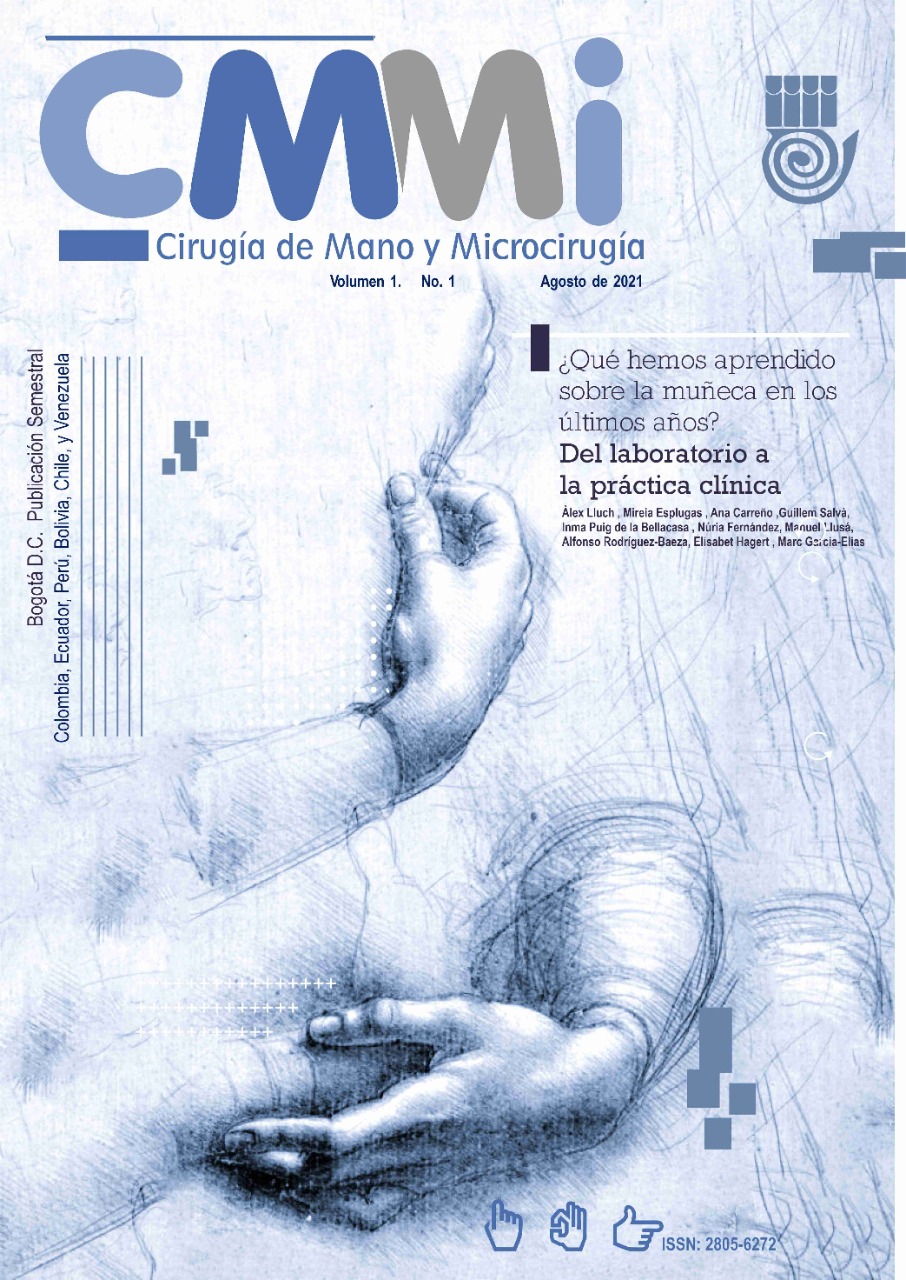Fractura osteocondral abierta del penacho de la falange distal en punta de dedo en niños: una lesión frecuentemente no diagnosticada
DOI:
https://doi.org/10.25214/28056272.1180Palabras clave:
Traumatismo de los dedos, Lesiones de la punta del dedo, Uñas, Matriz ungueal, Traumatismos de las manosResumen
La mano es la región del cuerpo más afectada por los traumatismos en los niños. Los más pequeños a menudo sufren traumas por aplastamiento en la punta del dedo, lesiones cuyo tratamiento recibe poca atención en el servicio de urgencias y que muchas veces deja secuelas importantes. En los menores de 4 años, la epífisis proximal de la falange distal no está calcificada, por lo que no es visible en las radiografías, y la porción calcificada es mucho más pequeña. Al comparar con niños mayores, en este grupo de edad la punta del dedo está formada y sostenida más por tejidos blandos y cartílago, ya que la falange está cubierta en toda su superficie por un casquete condral. Por tal razón, durante una lesión por aplastamiento con flexión de la porción distal de la punta del dedo, la región más frágil es la unión osteocondral del penacho de la falange. Esto provoca lesión con desprendimiento de la placa ungueal, lesión de la matriz ungueal estéril, laceración de la piel con hueso expuesto y fractura osteocondral. El objetivo del presente estudio fue describir, mediante el reporte de dos casos, el mecanismo y el tratamiento de la lesión por aplastamiento de la punta del dedo en niños pequeños con fractura osteocondral expuesta asociada a daño en la matriz ungueal. Este tipo de lesiones requieren mayor atención en urgencias y deben tratarse como una fractura abierta para reducir el riesgo de infección y secuelas funcionales.
Descargas
Referencias bibliográficas
Venkatesh A, Khajuria A, Greig A. Management of pediatric distal fingertip injuries: a systematic literature review. Plast Reconstr Surg Glob Open. 2020;8(1):e2595. DOI: 10.1097/ GOX.0000000000002595.
Wahba G, Cheung K. Pediatric hand injuries: practical approach for primary care physicians. Can Fam Physician. 2018;64(11):803-10.
Yorlets RR, Busa K, Eberlin KR, Raisolsadat MA, Bae DS, Waters PM, et al. Fingertip injuries in children: epidemiology, financial burden, and implications for prevention. Hand (N Y). 2017;12(4):342-7. DOI: 10.1177/1558944716670139. https://doi.org/10.1177/1558944716670139
Doraiswamy NV, Baig H. Isolated finger injuries in children--incidence and aetiology. Injury. 2000;31(8):571-3. DOI: 10.1016/s0020-1383(00)00052-8. https://doi.org/10.1016/S0020-1383(00)00052-8
Reid S, Duncan MJ. Interventions for treating fingertip entrapment injuries in children. Paediatr Child Health. 2016;21(1):27-8. DOI: 10.1093/pch/21.1.27. https://doi.org/10.1093/pch/21.1.27
Inglefield CJ, D'Arcangelo M, Kolhe PS. Injuries to the nail bed in childhood. J Hand Surg Br. 1995;20(2):258-61. DOI:10.1016/s0266-7681(05)80066-x. https://doi.org/10.1016/S0266-7681(05)80066-X
Ardouin T, Poirier P, Rogez JM. Les traumatismes des extrémités digitales et de l'appareil unguéal chez l'enfant. A propos de 241 cas. Rev Chir Orthop Reparatrice Appar Mot. 1997;83(4):330-4.
Al-Qadhi S, Chan KJ, Fong G, Al-Shanteer S, Ratnapalan S. Management of uncomplicated nail bed lacerations presenting to a children's emergency department. Pediatr Emerg Care. 2011;27(5):379-83. DOI: 10.1097/PEC.0b013e318216b22d. https://doi.org/10.1097/PEC.0b013e318216b22d
Silva JB, Gerhardt S. Trauma to the nail complex. Rev Bras Ortop. 2014;49(2):111-5. DOI: 10.1016/j.rboe.2014.02.005.10. Papadonikolakis A, Li Z, Smith BP, Koman LA. Fractures of the phalanges and interphalangeal joints in children. Hand Clin. 2006;22(1):11-8. DOI: 10.1016/j.hcl.2005.10.001. https://doi.org/10.1016/j.hcl.2005.10.001
Giddins GE, Hill RA. Late diagnosis and treatment of crush injuries of the fingertip in children. Injury. 1998;29(6):447-50. DOI: 10.1016/s0020-1383(98)00083-7. https://doi.org/10.1016/S0020-1383(98)00083-7
Schultz J, Schröttner P, Leupold S, Dragu A, Sußmann S, Haase M, et al. Conservative treatment of fingertip injuries in children - first experiences with a novel silicone finger cap that enables woundfluid analysis. GMS Interdiscip Plast Reconstr Surg DGPW. 2018;(7):Doc05. DOI: 10.3205/iprs000125.
Mirzaie M, Parsa A, Salehi M, Dahmardehei M, Moghadam MH, Mirzaie N. Epidemiology of hand injuries in children presenting to an orthopedic trauma center in southeast of Iran. Arch Bone Jt Surg. 2014;2(3):225-31.
Capstick R, Giele H. Interventions for treating fingertip entrapment injuries in children. Cochrane Database Syst Rev. 2014;2014(4):CD009808. DOI: 10.1002/14651858.CD009808.pub2. https://doi.org/10.1002/14651858.CD009808.pub2
O'Donovan DA, Mehdi SY, Eadie PA. The role of Mepitel silicone net dressings in the management of fingertip injuries in children. J Hand Surg Br. 1999;24(6):727-30. doi: 10.1054/jhsb.1999.0270. https://doi.org/10.1054/JHSB.1999.0270
Seymour N. Juxta-epiphysial fracture of the terminal phalanx of the finger. J Bone Joint Surg Br. 1966;48(2):347-9. https://doi.org/10.1302/0301-620X.48B2.347
Krusche-Mandl I, Köttstorfer J, Thalhammer G, Aldrian S, Erhart J, Platzer P. Seymour fractures: retrospective analysis and therapeutic considerations. J Hand Surg Am. 2013;38(2):258-64. DOI: 10.1016/j.jhsa.2012.11.015. https://doi.org/10.1016/j.jhsa.2012.11.015
Abzug JM, Kozin SH. Seymour fractures. J Hand Surg Am. 2013;38(11):2267-70. DOI: 10.1016/j.jhsa.2013.08.104. https://doi.org/10.1016/j.jhsa.2013.08.104
Lin JS, Popp JE, Balch Samora J. Treatment of acute Seymour fractures. J Pediatr Orthop. 2019;39(1):e23-7. DOI: 10.1097/BPO.0000000000001275. https://doi.org/10.1097/BPO.0000000000001275
Al-Qattan MM. Phalangeal neck fractures in children: classification and outcome in 66 cases. J Hand Surg Br. 2001;26(2):112-21. DOI: 10.1054/jhsb.2000.0506. https://doi.org/10.1054/jhsb.2000.0506
Kattan AE, AlShomer F, Alhujayri AK, Alfowzan M, Murrad KA, Alsajjan H. A case series of pediatric Seymour fractures related to hoverboards: increasing trend with changing lifestyle. Int J Surg Case Rep. 2017;38:57-60. DOI: 10.1016/j.ijscr.2017.06.058. https://doi.org/10.1016/j.ijscr.2017.06.058
Abzug JM, Ho CA, Ritzman TF, Brighton BK. Transphyseal fracture of the distal humerus. J Am Acad Orthop Surg. 2016;24(2):e39-44. DOI: 10.5435/JAAOS-D-15-00297. https://doi.org/10.5435/JAAOS-D-15-00297
Waters P, Beaty J, Kasser J. Elbow "TRASH" (The Radiographic Appearance Seemed Harmless) lesions. J Pediatr Orthop. 2010;30:S77-81. DOI: 10.1097/BPO.0b013e3181c18a9f. https://doi.org/10.1097/BPO.0b013e3181c18a9f
Al-Qattan MM. Extra-articular transverse fractures of the base of the distal phalanx (Seymour's fracture) in children and adults. J Hand Surg Br. 2001;26(3):201-6. DOI: 10.1054/jhsb.2000.0549. https://doi.org/10.1054/jhsb.2000.0549
Tan RE, Lim JX, Chong AK. Outcomes of phalangeal neck fractures in a pediatric population. J Hand Surg Am. 2020;45(9):880. e1-6. DOI: 10.1016/j.jhsa.2020.02.019. https://doi.org/10.1016/j.jhsa.2020.02.019
Van Beek AL, Kassan MA, Adson MH, Dale V. Management of acute fingernail injuries. Hand Clin. 1990;6(1):23-35. https://doi.org/10.1016/S0749-0712(21)01239-7
Klifto CR, Lavery JA, Gold HT, Milone MT, Karia R, Palusci V, Chu A. Pediatric fingertip injuries: association with child abuse.JHS GO. 2020;2(1):31-4. DOI: 10.1016/j.jhs
Descargas
Publicado
Cómo citar
Número
Sección
Licencia
Derechos de autor 2021 Revista Cirugía de mano y Microcirugía

Esta obra está bajo una licencia internacional Creative Commons Atribución 4.0.
| Estadísticas de artículo | |
|---|---|
| Vistas de resúmenes | |
| Vistas de PDF | |
| Descargas de PDF | |
| Vistas de HTML | |
| Otras vistas | |




